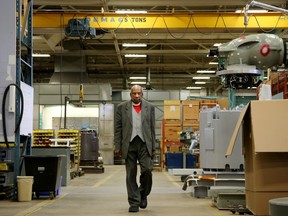Science
Kanata Nuclear Equipment Plant Faces Regulatory Deadline

The Canadian Nuclear Safety Commission (CNSC) has mandated that Best Theratronics, a Kanata-based manufacturer of nuclear medical equipment, submit a comprehensive inventory of its nuclear materials by November 5, 2023. This includes several tonnes of depleted uranium, which is crucial for their operations. Failure to meet this requirement could jeopardize the company’s operational licence.
Best Theratronics, which holds a class 1B licence allowing it to manufacture cyclotrons and medical devices, is under scrutiny following the CNSC’s recent inspection. During a review held in September, officials discovered 8,753 kilograms of depleted uranium, a by-product of uranium enrichment and commonly used in medical radiation therapy. The CNSC has made it clear that if Best Theratronics intends to transport these materials, it must provide a shipping plan for the sealed sources as well.
In a statement, CNSC spokesperson Braeson Holland emphasized the seriousness of the situation: “Failure to comply with the conditions of the order can lead to further regulatory measures, including licensing actions or other regulatory enforcement measures available under the Nuclear Safety and Control Act.”
The company, under the leadership of owner Krishnan Suthanthiran, has indicated plans to relocate some operations to the United States and India, a decision influenced by ongoing regulatory challenges in Canada. Earlier this year, Suthanthiran announced that Best Theratronics would cease producing equipment requiring CNSC compliance. This follows a tumultuous period marked by a nearly ten-month strike at the March Road facility and a ruling from the Canada Industrial Relations Board that deemed the company had failed to bargain in good faith.
Best Theratronics has also encountered difficulties regarding a $1.8 million decommissioning guarantee required by the CNSC. Suthanthiran has claimed that the company is “in the process of reviewing and responding to the CNSC order” and plans to comply with the requirements. The CNSC’s decision on October 22 highlighted the need for a financial guarantee that accurately reflects the company’s inventory.
The CNSC maintains that the risks associated with long-term storage of depleted uranium in Canada are minimal due to its limited quantities and strict safety protocols. As of 2009, Canada had approximately 1,500 metric tonnes of depleted uranium stored at a facility in Port Hope, Ontario, which is the only uranium conversion site in the country. In contrast, the United States had roughly 740,000 metric tonnes of depleted uranium in storage awaiting further processing.
Despite these regulatory challenges, Suthanthiran expressed confidence in the future of the Kanata plant, asserting there remains significant demand for non-radioisotope products such as blood irradiators. The workforce at the facility has decreased from about 200 workers before the strike to approximately 60 workers currently, highlighting the operational difficulties faced by the company.
The CNSC has noted ongoing “communications issues” with Best Theratronics. The commission expects the company to engage openly and collaboratively to resolve the current situation. As the November deadline approaches, the focus remains on compliance with regulatory requirements to ensure both public safety and the continuation of operations at the Kanata plant.
-

 World4 months ago
World4 months agoScientists Unearth Ancient Antarctic Ice to Unlock Climate Secrets
-

 Entertainment4 months ago
Entertainment4 months agoTrump and McCormick to Announce $70 Billion Energy Investments
-

 Lifestyle4 months ago
Lifestyle4 months agoTransLink Launches Food Truck Program to Boost Revenue in Vancouver
-

 Science4 months ago
Science4 months agoFour Astronauts Return to Earth After International Space Station Mission
-

 Technology2 months ago
Technology2 months agoApple Notes Enhances Functionality with Markdown Support in macOS 26
-

 Top Stories4 weeks ago
Top Stories4 weeks agoUrgent Update: Fatal Crash on Highway 99 Claims Life of Pitt Meadows Man
-

 Sports4 months ago
Sports4 months agoSearch Underway for Missing Hunter Amid Hokkaido Bear Emergency
-

 Politics3 months ago
Politics3 months agoUkrainian Tennis Star Elina Svitolina Faces Death Threats Online
-

 Politics4 months ago
Politics4 months agoCarney Engages First Nations Leaders at Development Law Summit
-

 Technology4 months ago
Technology4 months agoFrosthaven Launches Early Access on July 31, 2025
-

 Top Stories2 weeks ago
Top Stories2 weeks agoFamily Remembers Beverley Rowbotham 25 Years After Murder
-

 Top Stories6 days ago
Top Stories6 days agoBlake Snell’s Frustration Ignites Toronto Blue Jays Fan Fury















